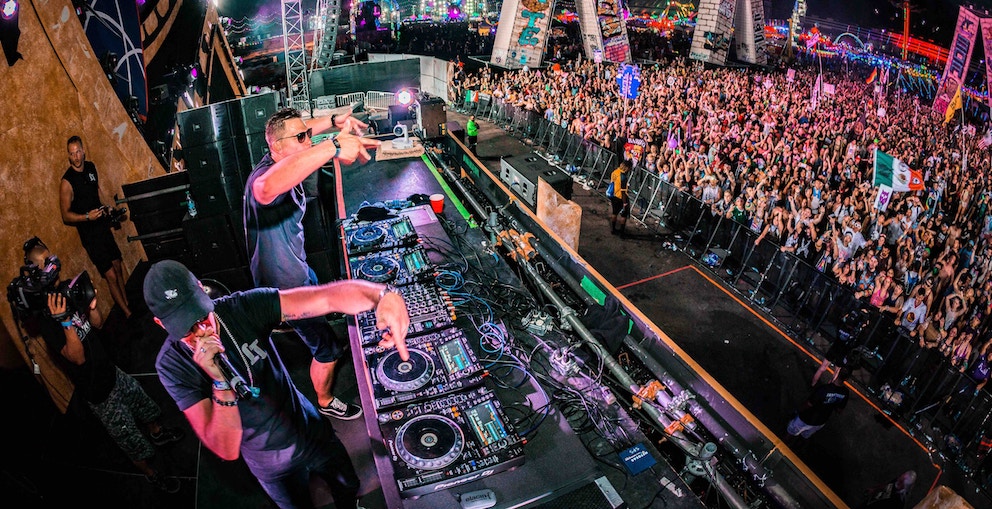In the DJ world, there’s one skill more important than any other: knowing how to read a dance floor. Everything else falls flat in comparison. In today’s article, contributor Teo Tormo shares critical insight on what every DJ should do before and during a gig to understand what a crowd wants.
DJ, Meet The Dance Floor
Have you ever seen a DJ who doesn’t try to mix, can’t manually beatmatch, and has a mediocre knowledge of DJ gear – but was still able to rock a party? Usually this is because they’re good at one thing: reading and reacting to their audience.
If you asked what the most important skill any DJ can have, my answer is always, “know how to read the dance floor.” I’ve heard others say something similar: “knowing the psychology of a dance floor.” Without that skill, everything else will not matter. It’s clear especially to me, because it’s something that I didn’t know how to do for a long time. When I learned basic concepts about reading crowds, I discovered important positive differences in the results of my work.

DJs Only Watching Their Gear Will Know Nothing
You’ve heard of Serato face before, right? A common mistake that new DJs make is spending a whole DJ set only looking at the equipment. Whatever gear you use (MIDI controller, media players, turntables), you need to develop the ability to pay equal attention to the equipment and dance floor.
You need to have mastered your equipment and know how to look at it as little as possible. This can mean:
- Knowing where each button/knob is / being able to find controls by touch
- Knowing how much pressure it takes to activate this or that control
- Being able to put the needle on a record in the dark, from the edge of your vision
- Having playlists well-organized so you can quickly find your next track in a few seconds
You should aim for almost every interaction with your setup to be based in muscle memory. This frees up your eyes to spend as much time as possible looking out on the dance floor.
Beyond being able to learn more from watching their dance floor, DJs who only stare at their gear create a feeling of disconnection and disaffection in a crowd. This can quickly lead to empty dance floors and negative feelings about the DJ – and audiences will remember that.

Being aware of the dance floor does not mean you have to entertain the crowd by dancing and gesticulating wildly. Dance and enjoy yourself and you should try to have a smile in your face (it projects confidence!), but be careful not to become a spectacle for your behind-booth movements. Creating an atmosphere and building a dance floor is rooted in your music and mixing, not how high you can jump. Yes, festival DJs often overdo their onstage antics, but that is so rarely why people are enjoying themselves.
Scout It Out: Investigate Venues Like A Pro

No two clubs are the same, nor is the audience that attends. Here’s a basic checklist of things to figure out about a venue before you play it – think of it as field research for your gig!
- Where is it, and what other important clubs are nearby?
- What’s the venue capacity?
- Typically, what is the expected vibe at different times of night?
- When do people actually start to arrive? Many venues are empty when they open and the first DJ comes on.
- What time does the vibe/music/attendance peak, and then when do people start to leave?
- Who are the people coming out? (Locals, tourists, students, bottle service, bar patrons, dates, etc)
- What music is played, and what seems to work the best with the audience?
- Do people come to this club to talk and socialize, or are they going just for dancing?
This probably seems like a lot of information. It is! Most likely you won’t learn it all just in one night of scouting, but the more you find out, the better pre-selection of music you’ll be able to do for your gig.
- If the venue is in your city: go to the club as a regular attendee. Drink some caffeine to be fresh all night long, find a comfortable place in the club to listen and watch for several hours. Think of it like watching a National Geographic documentary about nightlife!
- If the venue isn’t nearby, do research! Study club flyers, event pages, social networks, and specialized nightlife magazines and/or clubber guides. You can also try to reach a resident DJ via email and ask them for some insight. You can also ask club manager, owner, or booker if it feels right. Consider checking out media from the club – people’s posts on Instagram, photo galleries on Facebook, and so on.
Tips That (Usually) Don’t Fail
What happens on a dance floor depends a lot on the club and the crowd. Many other factors (day of the week, weather, season) can have an impact, but a number of things tend to work in a similar way everywhere:
The Requests

Taking requests isn’t about the dance floor – it’s often more about interacting with individuals or a small group of people. At certain events, requests are inevitable (weddings, corporate parties), but in general, in medium or small venues where mainstream music is played, it is necessary to know how to manage requests with care and respect. Here’s a few tips:
- Always be kind accepting or denying requests.
- If you’re playing a specific music genre and people are there to listen and dance to that genre, any request outside that context should be rejected
- Don’t take requests for your entire set – let yourself get into the groove first!
- Try to identify groups of people who are requesting things and determine if it’s “worth” taking a request based on the results. This can be hard – sometimes, you’ll take a request and a dance floor will double – but other times, no one (including the requester) will enjoy it.
- Never give a definitive “yes” even if you are going to play the request. This is expectation management! Try saying something like “I’ll try to play it later” or “I think I have it, I will look for it”.
- If you love taking requests, find a balance so that you don’t get a line of people next to the boothand end up distracting yourself from mixing. Make kind gestures to the people that try to reach you to let them know that you are aware of them but they have to wait a little, and don’t play the request in the same moment that is made. Making people wait a little will help you a lot, they have to understand that accepting requests doesn’t mean they take control of the booth.
- Keep a careful eye on your gear. If people come too close to the DJ booth or approach it from the wrong angle, there’s a good chance of drinks or stray hands finding their way right onto the pause button on your CDJs.
Set Structure: Time, Tempo, Intensity

Except in very specific genres, DJs should distribute the musical intensity throughout their set. Think of this as the energy level of the music you’re playing. If appropriate, you might also want to adjust the tempo of the music you’re playing. Everything has an order and a right moment. Here’s some advice for a typical DJ set – but remember, this can be very different for unique clubs and genres.
- It’s best not to start with a high tempo or energy level for your genre. Don’t play a peak-hour track first, right? It’s hard for people connect with your set if you start too strong and fast. You want to create anticipation and keep people interested.
- Consider dividing your set into four “acts” – in the first act, keep it fairly linear, maintain a stable tempo and energy level, and try not to play too many classic tracks or floorfillers.
- During the second act, you might start raising the tempo of the session or increasing the intensity. A few floorfillers are welcome now.
- The third act is the most complex. People are already “hot” and ready to have a good time, or to leave looking for another club if the upcoming music and mixes are not what they desire. I personally increase the tempo and play “triads” (three consecutive songs that work well together, read more about triads below). In the final stretch of the third act.take everything to a high point of tempo and intensity. so that everyone notices that the fourth act arrives.
What’s a triad? Many DJs who play weekly gigs have a established batches of songs that work well together. I recommend group them into three song triads.
A triad should usually have songs with the same genre, tempo, and intensity. More importantly, you should have already rehearsed “power transitions” between them. After each “triad” it’s okay to let people breathe a bit. It’s a bit of prep – but you’ll find certain triads work really well and are worth keep in your arsenal for future gigs.
For regular DJs, it’s good practice to modify your successful triads every so often. Don’t play the same groups of songs each week – the regulars notice, and you might become boring and predictable.
- The final/fourth act is the continuation of the peak. If you’ve done great work until now, the whole crowd is hooked. Reward those who have endured on the dance floor and keep the intensity high! Give less “breathing time” between tracks, and release the hits and floorfillers that remain in your playlists.
- The fourth act is also a good time to do show off technical prowess. Are you skilled with FX, or have some kind of routine that you are good at? This is the moment to bust it out and wow the crowd – they’re paying attention.
- At the tail end of the fourth act is a good time to lower the intensity and tempo. If you’re the last DJ, you might have to encourage people out of the club. The music should somewhat indicate that – so help the the security staff out by pulling things back a bit and winding down the night.
Troubleshooting A Crowd
Reading these tips can be great in theory, but in practice it can be very hard unless you’re very experienced. Here are some frequently encountered challenges – and tips for handling them:
People don’t start dancing: Is the crowd sitting down, ignoring the music, or just gathered around the bar? Two common causes: the intensity of the music is off, or you haven’t “tempted” anyone onto the dance floor with a song that connects to them. To avoid this, try to look for the people at the start of your set who are more lively and have danced a little. What music got them moving? These first dancers often hook others onto the dance floor. Give them more of what they want and keep them moving and excited.
Things were going well for a while, but then the dance floor started to empty: You might have burned out people with excessive intensity (often during the second or third act). You might need to adjust your intensity, adapt the music to the situation, and give your crowd a break before restarting a ramp up to an intensity peak. This time do not go as fast as before.
Another common cause for this is playing two or more consecutive songs that don’t match the desire of the crowd. If you notice this happen, forget about the rules. Mix out as soon as you can into a safe floor filler.
People are on the dance floor, but they’re are staring at me and not dancing: This strange situation often leads to people leaving the club too early. Here the mistakes can be several at the same time. Make sure that you are:
- letting songs play long enough (don’t mix really fast to the next track if people are enjoying it)
- not moving too abruptly between genres/BPMs
- beatmatching your tracks precisely
- not abusing FX and ruining tracks
- matching the vibe of the night with your selections (don’t play a tropical house remix at a hard techno night)
Never Stop Observing

This article isn’t a guide of absolute truths or infallible tricks. You’ve got to create your own method and develop your own tricks. To do this, keep observing and analyzing the audience and their reactions.
It’s not hard to detect boredom: arms crossed, hips stopped, people talking too much instead of dancing, eyes with the thousand-yard stare. It’s also easy to see when people are having a good time: arms and hands moving in the air, people following the rhythm with their whole body, and the most connected people dancing with their eyes closed.
There’s always time to correct mistakes – most people don’t leave a club right away when something is off. Instead, they’ll hang around for a while waiting for a change; if it doesn’t come, then they’ll
If your night goes wrong, apart from lamenting, always try to learn something. Check the tracklist and meditate on if the songs were the right ones for that place, that audience and that event. If you recorded the session, listen to it by and check for a good distribution of intensity.
No one is born knowing how to read a crowd – so use every gig wisely, practice, and gain experience.
djtechtools.com







Comment here